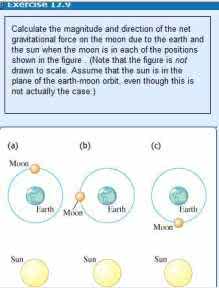At a certain instant, the earth, the moon, and a stationary 1220 kgspacecraft lie at the vertices of an equilateral triangle whosesides are 3.84 \times 10^{5}\:{\rm km} in length.
Find the magnitude of the net gravitational force exerted on thespacecraft by the earth and moon.
Take the gravitational constant to be 6.673 \times 10^{-11}\:{\rmN} \cdot {\rm m}^{2}/{\rm kg}^{2}, the mass of the Earth to be 5.97\times 10^{24}\:{\rm kg}, the mass of the Moon to be 7.35 \times10^{22}\:{\rm kg}.
Find the direction of the net gravitational force exerted on thespacecraft by the earth and moon. State the direction as an anglemeasured from a line connecting the earth and the spacecraft.
What is the minimum amount of work that you would have to do tomove the spacecraft to a point far from the earth and moon? You canignore any gravitational effects due to the other planets or thesun.
At a certain instant, the earth, the moon, and a stationary 1220 kgspacecraft lie at the vertices of an equilateral triangle whosesides are 3.84 \times 10^{5}\:{\rm km} in length.
Find the magnitude of the net gravitational force exerted on thespacecraft by the earth and moon.
Take the gravitational constant to be 6.673 \times 10^{-11}\:{\rmN} \cdot {\rm m}^{2}/{\rm kg}^{2}, the mass of the Earth to be 5.97\times 10^{24}\:{\rm kg}, the mass of the Moon to be 7.35 \times10^{22}\:{\rm kg}.
Find the direction of the net gravitational force exerted on thespacecraft by the earth and moon. State the direction as an anglemeasured from a line connecting the earth and the spacecraft.
What is the minimum amount of work that you would have to do tomove the spacecraft to a point far from the earth and moon? You canignore any gravitational effects due to the other planets or thesun.

